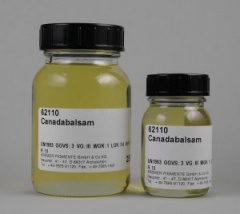Canada Balsam
| Infobox on Canada Balsam | |
|---|---|
| Example of Canada Balsam |  |
| Facts | |
| Origin | - |
| Density (in t/m3) | - |
| Temperature (in oC) | - |
| Humidity / moisture | - |
| Ventilation | - |
| Self-heating / spontaneous combustion | - |
| Risk factors | - |
Canada Balsam
Contents
Description
Canada balsam, also called Canada turpentine or balsam of fir, is a turpentine which is made from the resin of the balsam fir tree (Abies balsamea). The resin, dissolved in Essential Oils, is a viscous, sticky, colourless (sometimes yellowish) liquid, that turns to a transparent yellowish mass when the essential oils have been allowed to evaporate.
Canada balsam is amorphous when dried. It does not crystallize with age, so its optical properties do not deteriorate. However, it has poor thermal and solvent resistance.
Due to its high optical quality and the similarity of its refractive index to that of crown glass (n = 1.55), purified and filtered Canada balsam was traditionally used in optics as an invisible-when-dry glue for glass, such as lens elements. The lenses glued with Canada balsam (or with other similar glues) are called cemented lenses. Also other optical elements such as two prisms to form a beam splitter can be cemented with Canada balsam. Balsam was phased out as an optical adhesive during World War II, in favour of polyester, epoxy and urethane-based adhesives. In modern optical manufacturing UV-cured epoxies are often used to bond lens elements.
Canada balsam was also used for making permanent microscope slides. In biology, for example, it can be used to conserve microscopic samples. The sample is sandwiched between a microscope slide and a coverslip. Canada balsam is used to glue the arrangement together and enclose the sample to conserve it. Xylene balsam is Canada balsam dissolved in xylene.
It is used for preparing slide mounts. Some workers prefer terpene resin as it is both less acidic and cheaper than balsam. Synthetic resins have largely replaced organic balsams for such applications.
Some other uses (traditional and current) include:
- In geology, it is used as a common thin section cement and glue, and is used for refractive index studies and tests, such as the Becke line test.
- To fix scratches in glass (car glass for instance) as invisibly as possible.
- In oil painting, to achieve glow and facilitate fusion.
- In Buckley's cough syrup.











